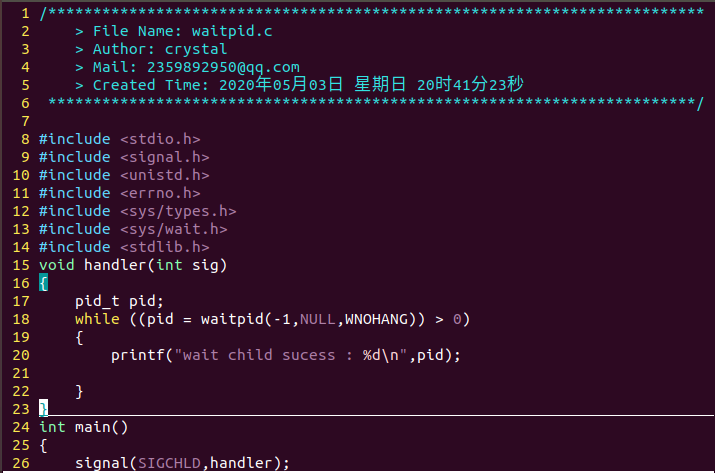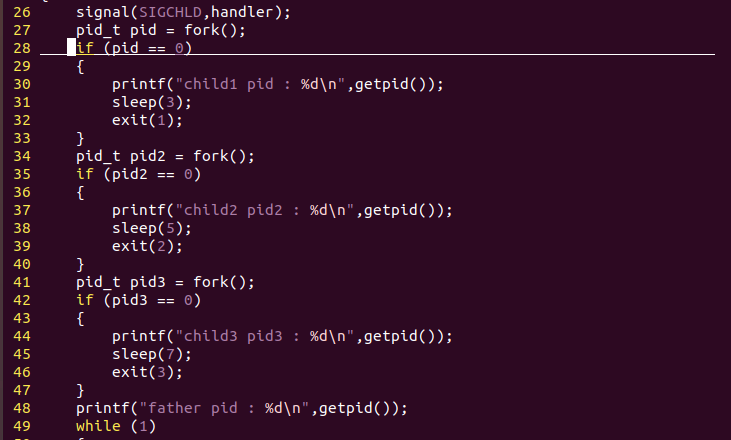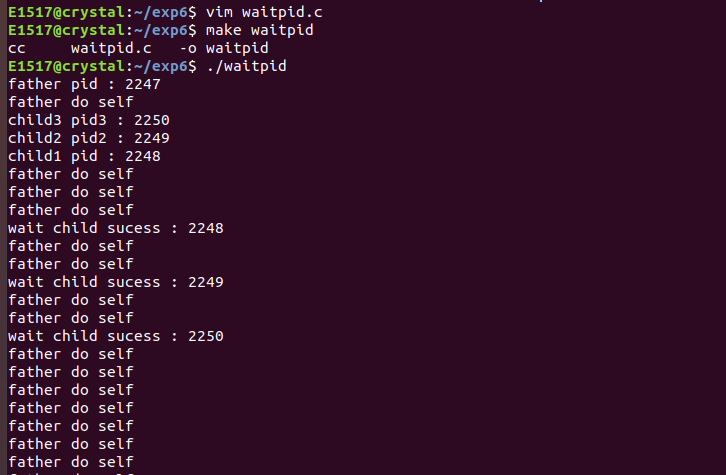| 项目 | 内容 |
|---|---|
| 这个作业属于哪个课程 | 2020春季Linux系统与应用(南昌航空大学 - 信息工程学院) |
| 这个作业的要求在哪里 | 作业链接,点这里啦! |
| 学号-姓名 | 17041517-漆京 |
| 作业学习目标 | 1、掌握Linux系统环境C语言编程概念 2、学习Linux系统进程概念 |
1,请举例说明静态链接库的创建与使用。
ar:静态函数库创建的命令
-c :create
-r :replace
表示当前插入的模块名已经在库中存在,则替换同名的模块;
如果若干模块中有一个模块在库中不存在,ar显示一个错误信息,并不替换其他同名的模块。
//文件名:add.c,加法
int add(int a,int b){
return a+b;
}
//文件名:sub.c,减法
int sub(int a,int b){
return a-b;
}
//文件名:main.c
#include <stdio.h>
int add(int a,int b);
int sub(int a,int b);
int main(){
printf("3 + 1 = %d
",add(3,1));
printf("3 - 1 = %d
",sub(3,1));
return 0;
}


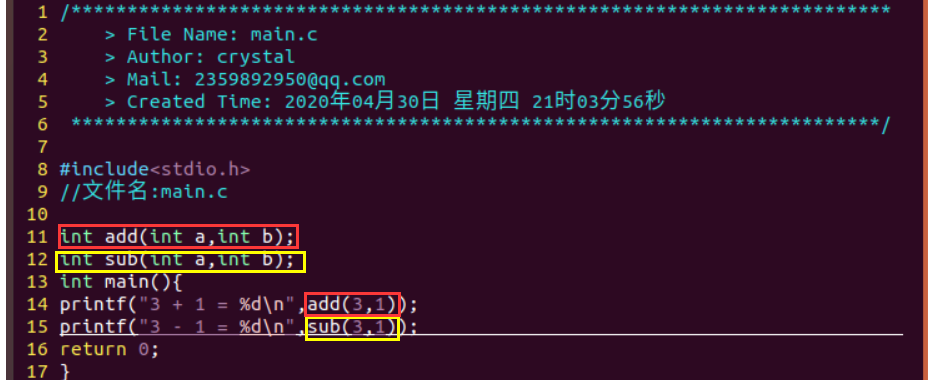
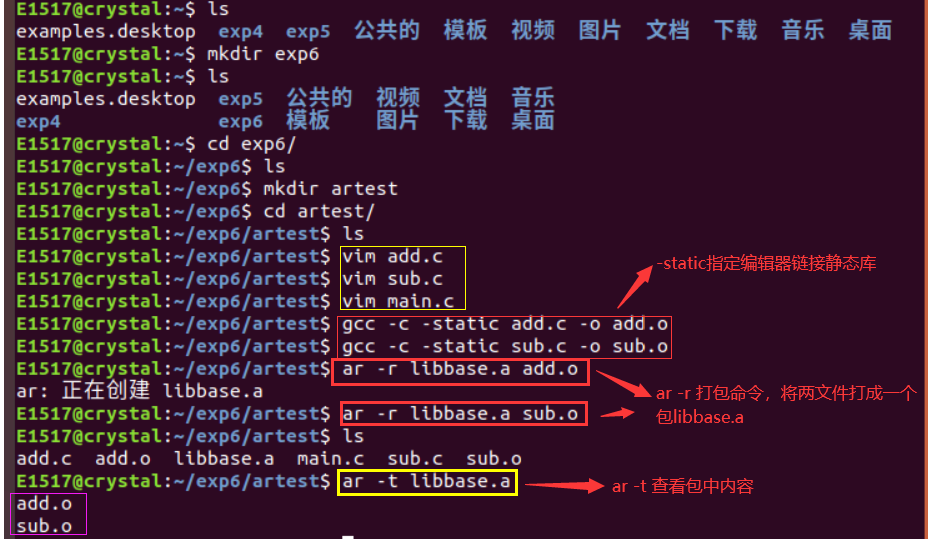

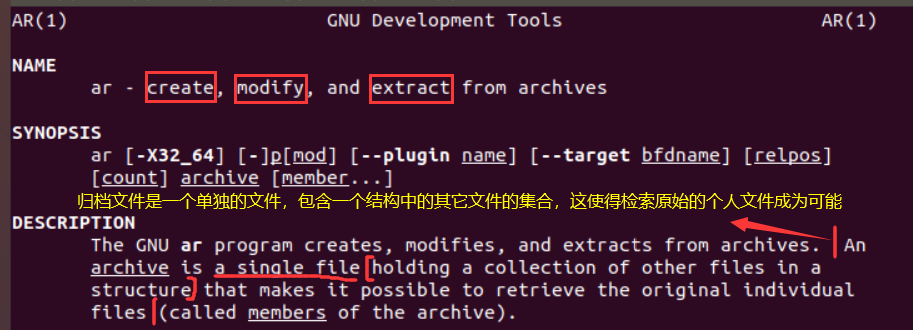
2、请举例说明共享库的创建与使用。
#include <iostream>
using namespace std;
//文件名:common.h
#ifndef _COMMON_
#define _COMMON_
int add(int a,int b)
int sub(int a,int b)
#endif
开始的目录结构:
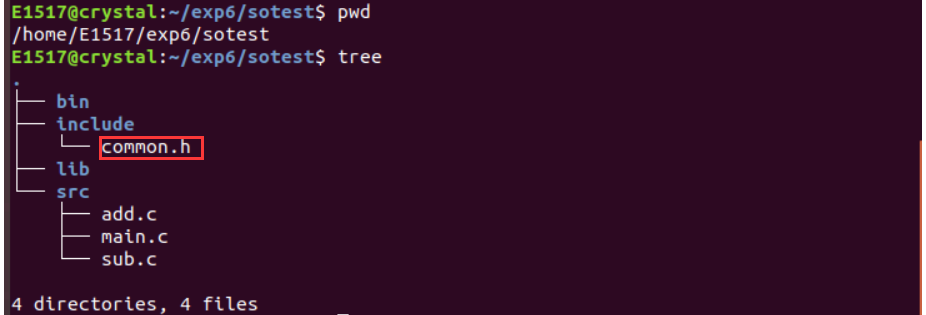
观察下面的目录结构,与开始的目录结构对比:
(1)创建共享库
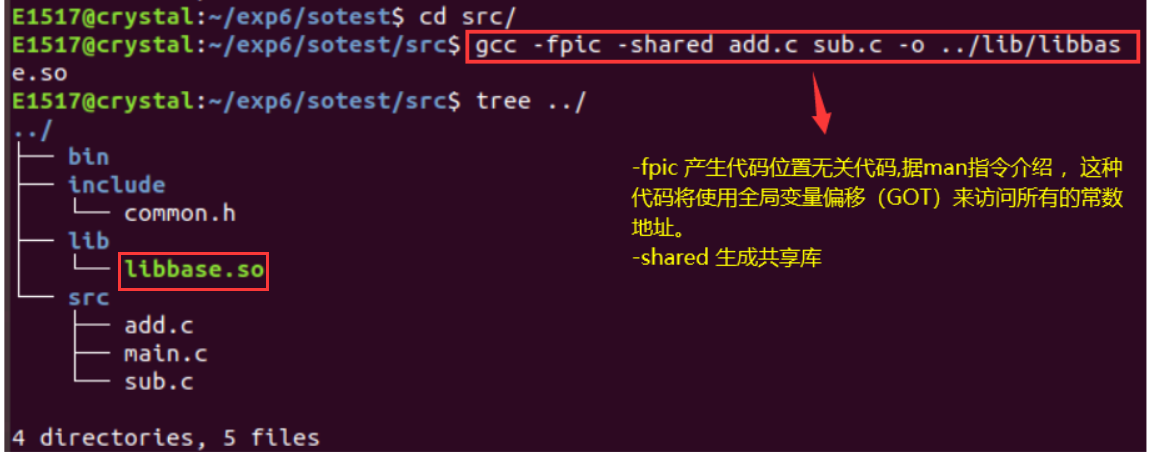
(2)使用自己的共享库
方式一:指定相对路径
方式二:只给链接器动态库名称(若要正常实现,后面必须添加一个环境变量)
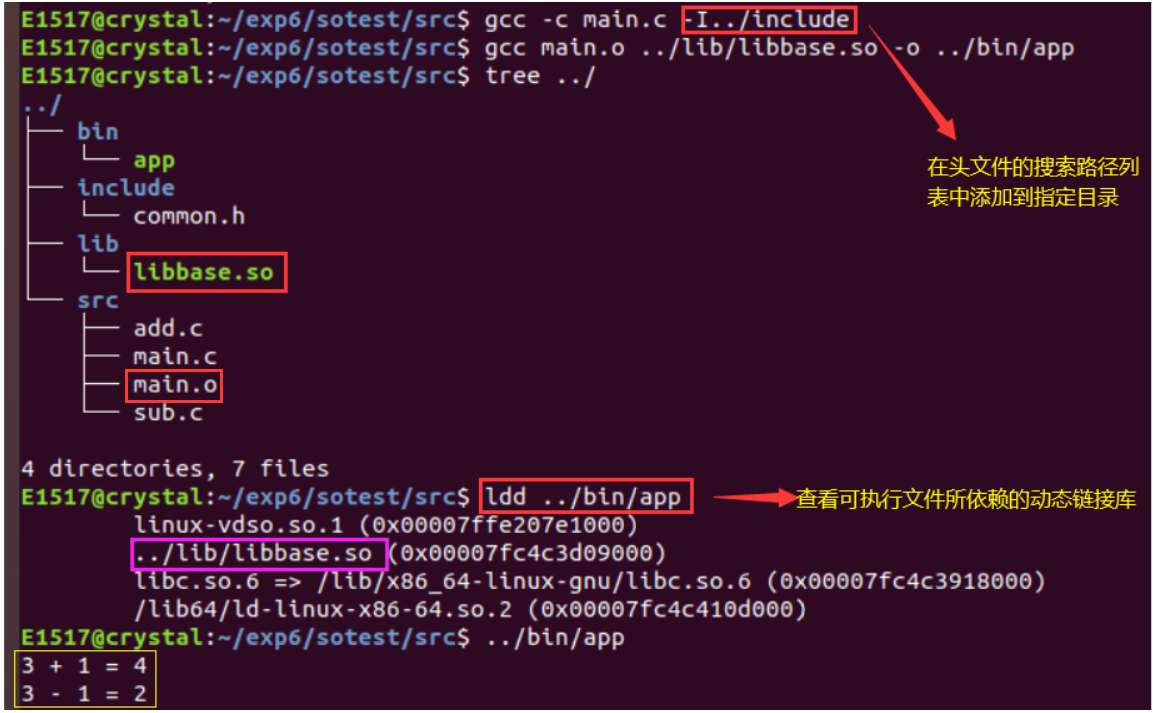
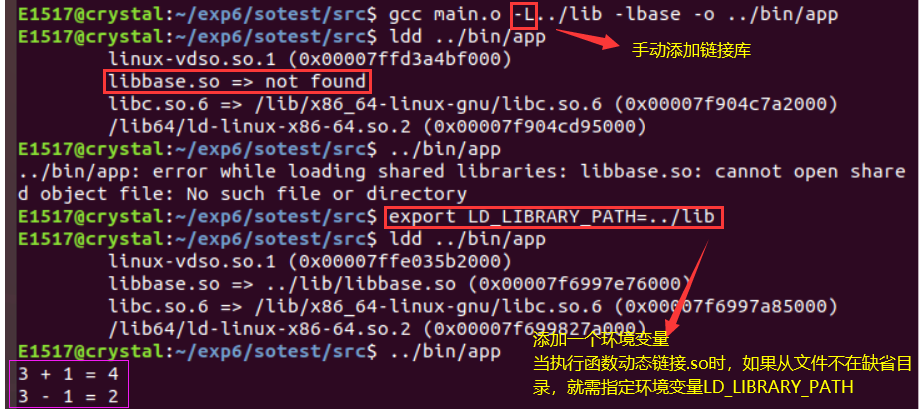
3、 编程实现一个简单文件复制命令。(文件I/O)
man命令简介:
man是manual(手册)的缩写,使用man这个命令可以调阅其中的帮助信息
man的使用方法:
使用命令"man [N] passwd"其中N(1-9,n)参数指定手册页的类型
-a:在所有的man帮助手册中搜索
-f:显示给定关键字的简短描述信息
-P:指定内容时使用分页程序
-M:指定man手册搜索的路径
#include <unistd.h>
#include <sys/types.h>
#include <sys/stat.h>
#include <fcntl.h>
#include <stdio.h>
#define BUFFERSIZE 4096
int main(int argc, char* argv[]) {
if (argc != 3) {
printf("usage:
mycp src dst
");
return 1;
}
int srcfd = open(argv[1], O_RDONLY);
if (srcfd == -1) {
perror("open");
return 1;
}
int dstfd = open(argv[2], O_CREAT | O_WRONLY, 0666);
if (dstfd == -1) {
close(srcfd);
perror("open");
return 1;
}
int len = 0;
char buffer[BUFFERSIZE] = {0};
while((len = read(srcfd, buffer, BUFFERSIZE)) > 0) {
if (write(dstfd, buffer, len) != len) {
perror("write error");
return 1;
}
}
if (len < 0) {
perror("read error");
return 1;
}
close(srcfd); // 关闭文件
close(dstfd);
return 0;
}

比较复制前后文件的异同:
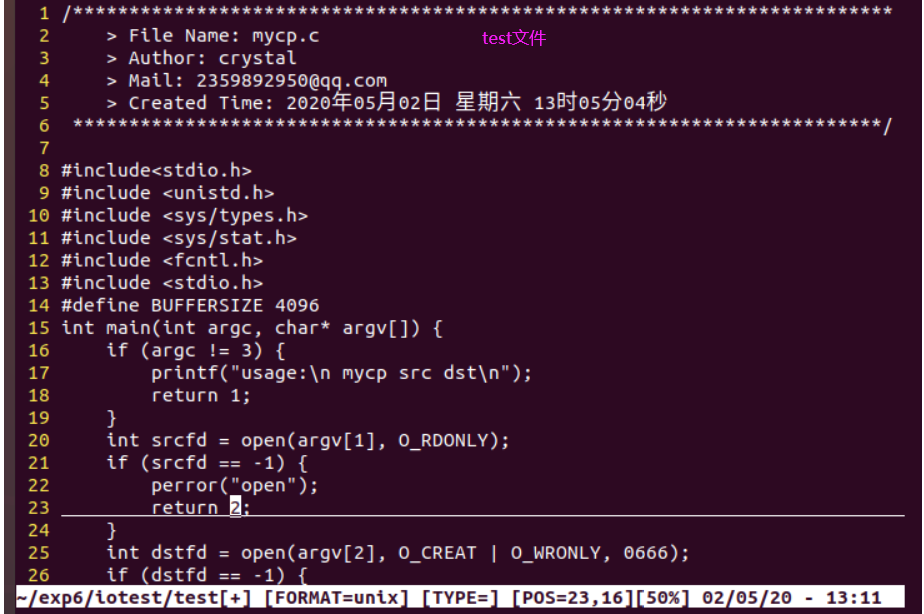
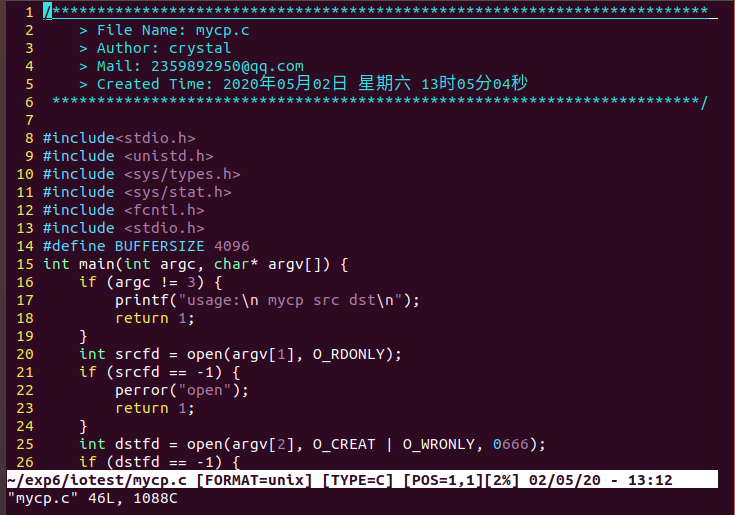
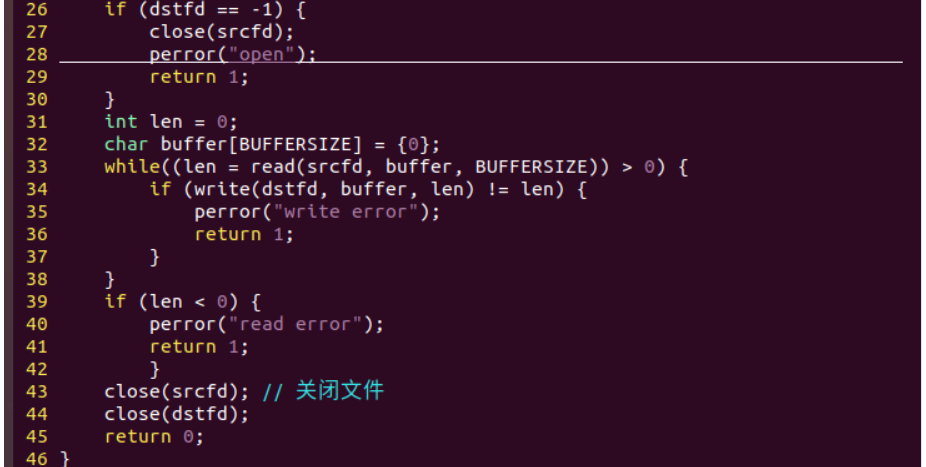
4、使用 fork 创建一个子进程,进程创建成功后父子进程分别输出不同的内容。
fork函数简介
(1)依赖的头文件 #include <unistd.h>
(2)fork的原理和概念:
fork子进程就是从父进程拷贝一个新的进程出来,子进程和父进程的进程ID不同,但用户数据一样。
(3)父进程和子进程
执行fork函数后有2种返回值:
对于父进程,返回的是子进程的PID(即返回一个大于0的数字);
对于子进程,则返回0,所以我们可以通过pid这个返回值来判断当前进程是父进程还是子进程。
#include <stdio.h>
#include <stdlib.h>
#include <unistd.h>
int main(){
pid_t pid;
printf("[%d]:Begin!
",getpid());
fflush(NULL);
pid = fork();
if(pid<0)
{
perror("fork()");
exit(1);
}
else if(pid > 0)
{
printf("[%d]:Parent process if working!
",getpid());
}
else
{
printf("[%d]:Child process if working!
",getpid());
}
printf("[%d]:Finish!
",getpid());
return 0;
}
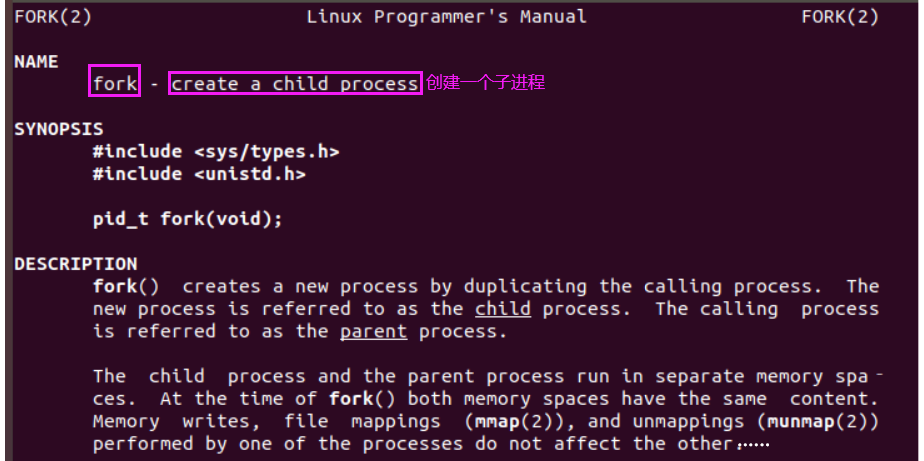
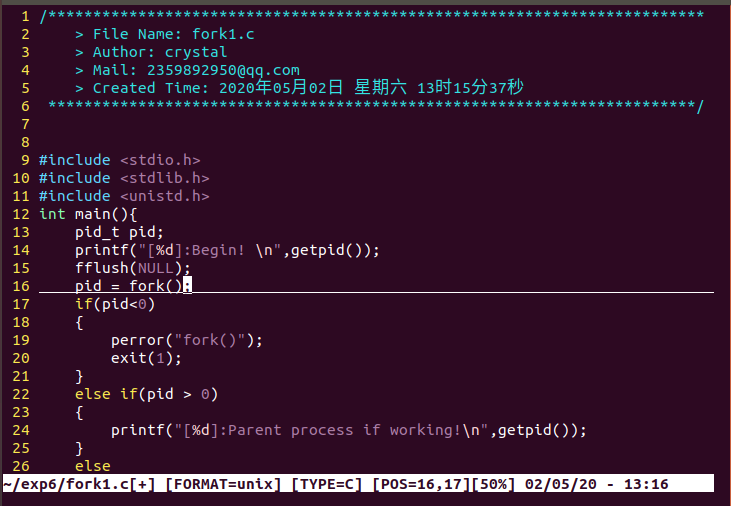

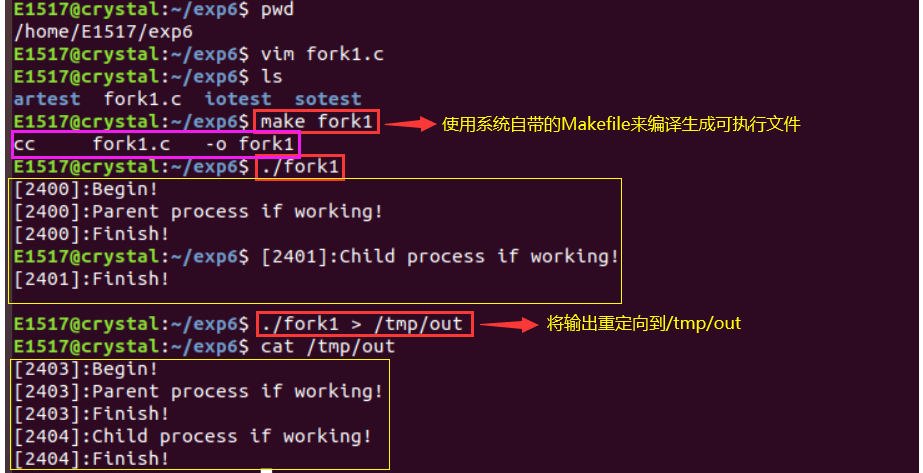
全缓冲:
全缓冲指的是系统在填满标准IO缓冲区之后才进行实际的IO操作;
注意,对于驻留在磁盘上的文件来说通常是由标准IO库实施全缓冲。
行缓冲:
在这种情况下,标准IO在输入和输出中遇到换行符时执行IO操作;
注意,当流涉及终端的时候,通常使用的是行缓冲。
删除fflush(NULL);//查看运行结果区别
./fork1 > /tmp/out 输出结果删除后子程序工作前多个 Begin!
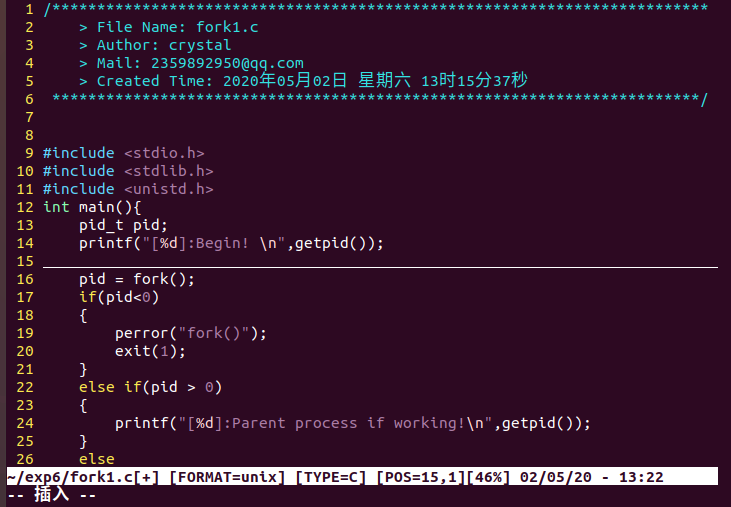

进一步删除15行
,查看运行结果区别
删除后 Begin! 与 父进程、子进程间不换行
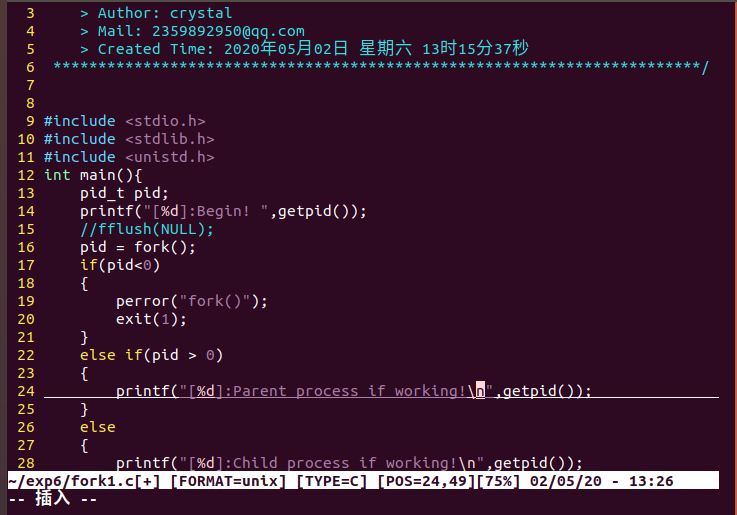
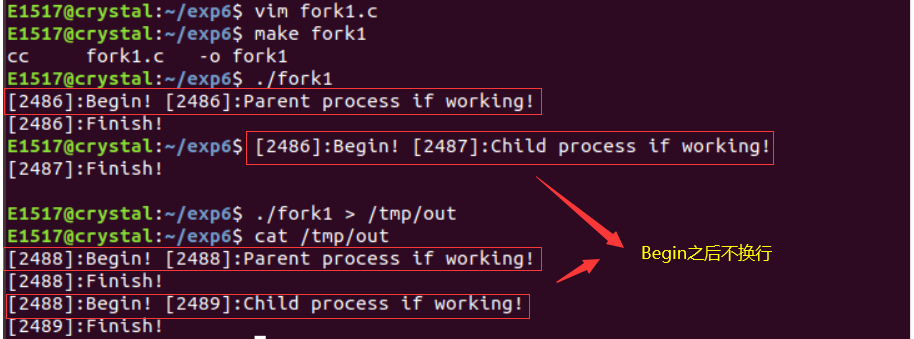
5、 使用fork创建多个子进程。
int i;
pid_t pid;
for (i = 0; i < 3; i++)
pid = fork();
上面代码段会产生多少子进程?
2^3-1=7
产生7个子进程
#include <stdio.h>
#include <stdlib.h>
#include <unistd.h>
int main(){
int i;
pid_t pid;
printf("[%d] Begin!
",getpid());
for (i = 0;i < 3; i++)
{
if((pid = fork()) ==0 )
break;
}
if(pid<0)
{
perror("fork()");
exit(1);
}
else if(pid > 0)
{
printf("[%d] Parent process is working!
",getpid());
}
else
{
printf("[%d] Child process %d is working!
",getpid(),i);
}
return 0;
}


使用sleep函数简单控制进程输出顺序
#include <stdio.h>
#include <stdlib.h>
#include <unistd.h>
int main(){
int i;
pid_t pid;
printf("[%d] Begin!
",getpid());
for (i = 0;i < 3; i++)
{
if((pid = fork()) ==0 )
break;
}
if(pid<0)
{
perror("fork()");
exit(1);
}
else if(pid > 0)
{
sleep(3);
printf("[%d] Parent process is working!
",getpid());
}
else
{
sleep(i);
printf("[%d] Child process %d is working!
",getpid(),i+1);
}
return 0;
}
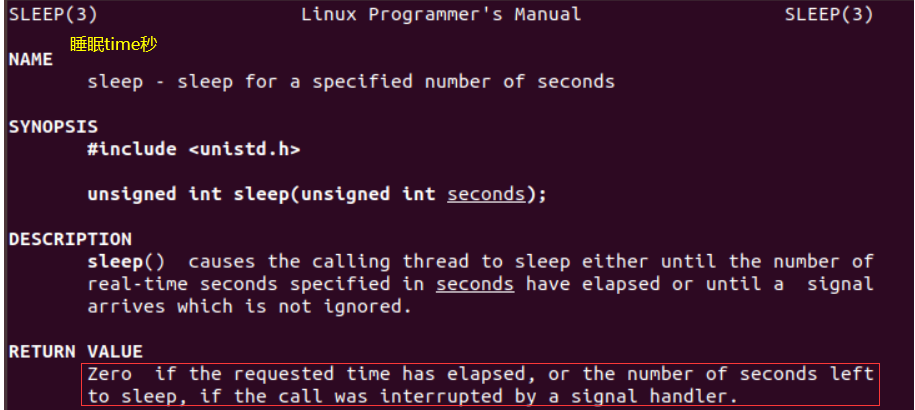
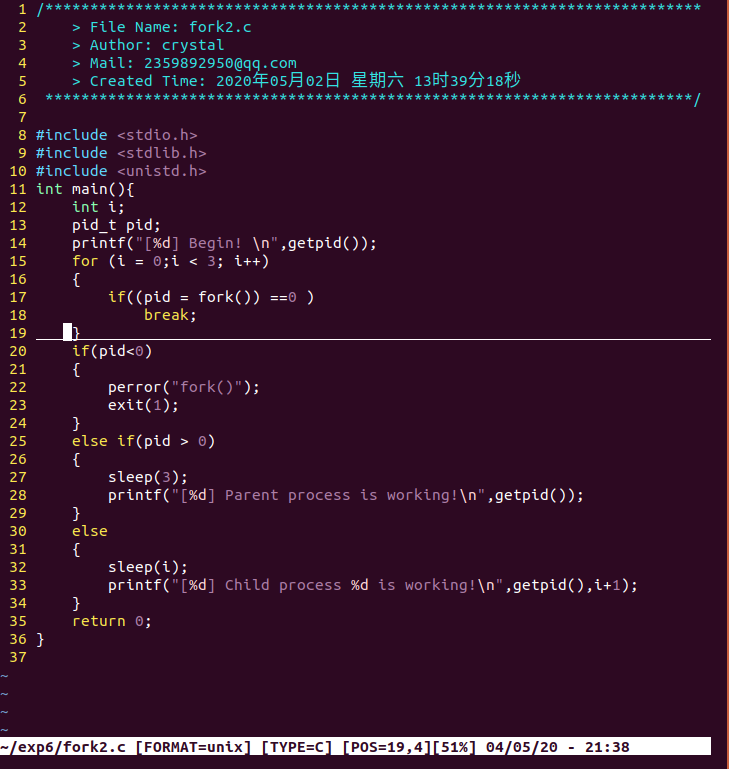

6、在 fork 之前以写的方式创建了一个文件 test.txt。然后 fork 出的子进程立即向文件中写入
“world”,然后睡眠5秒。而父进程在 fork 后睡眠3秒后向 test.txt 写入 "hello",并关闭描述符。子
进程恢复后,又向 test.txt 文件中写入 "lalala"后关闭描述符,结束。
#include <unistd.h>
#include <sys/types.h>
#include <sys/stat.h>
#include <fcntl.h>
#include <stdio.h>
int main() {
int fd = open("test.txt",O_WRONLY | O_CREAT,0664);
if (fd == -1){
perror("open");
return 1;
}
printf("I'm father
");
printf("before fork
");
pid_t pid = fork();
if (pid > 0){
sleep(3);
printf("I'm father; I'm writing test.txt...
");
write(fd, "hello", 5);
close(fd);
}
else if (pid ==0){
printf("I'm child; I'm writing test.txt...
");
write(fd, "world", 5);
sleep(5);
write(fd, "lalala", 6);
close(fd);
}
else {
perror("fork");
return 1;
}
return 0;
}
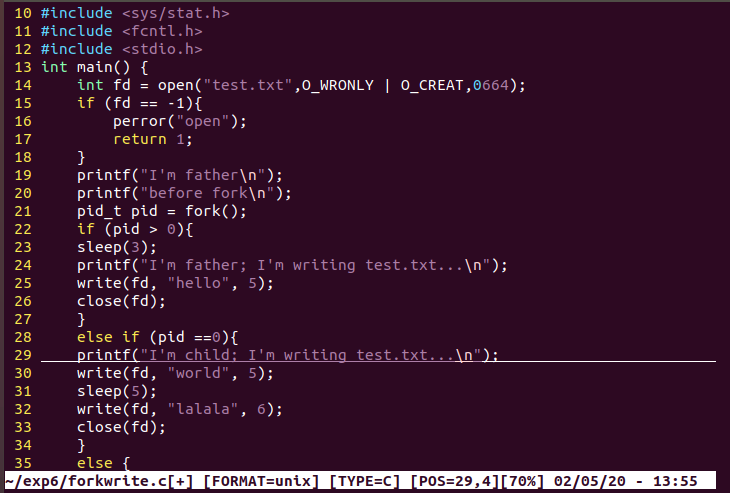


7、分别在主函数中使用
execvp 启动 ls 命令以及使用 fork 函数产生子进程调用 execvp 启动 ls 。
程序调用execvp,实现一个程序运行另一个程序
(1)使用execvp启动ls命令
#include <stdio.h>
#include <stdlib.h>
#include <unistd.h>
int main(){
char* argv[] = {"ls","-l",NULL};
if (execvp("ls",argv) == -1){
perror("exec");
return 1;
}
return 0;
}
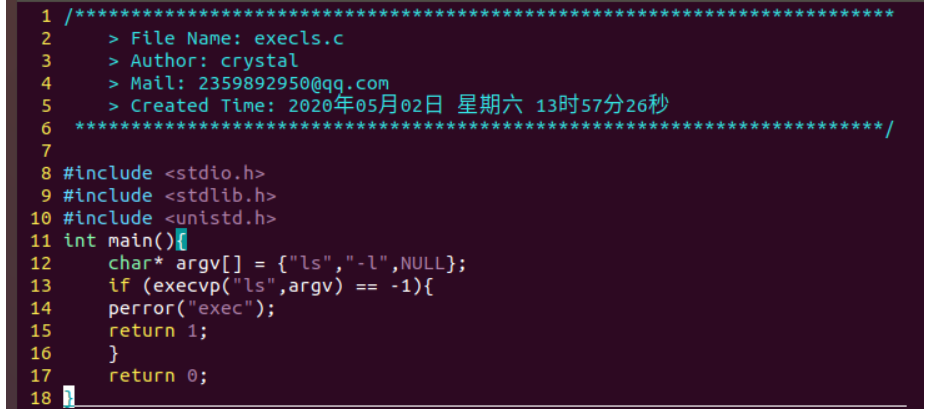
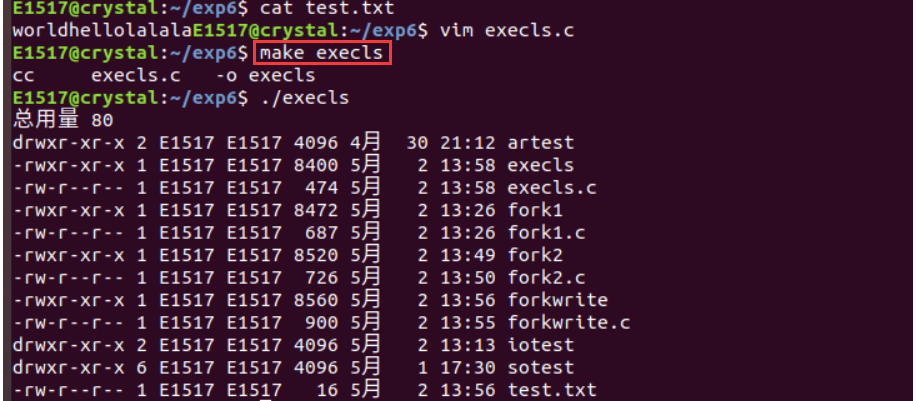
(2)使用fork函数产生子进程调用execvp启动ls
#include <stdio.h>
#include <stdlib.h>
#include <unistd.h>
int main(){
char* argv[] = {"ls","-l",NULL};
pid_t pid = fork();
if (pid > 0){
printf("I'm father
");
}
else if (pid == 0) {
printf("I'm child
");
if (execvp("ls",argv) == -1){
perror ("exec");
return 1;
}
}
else {
perror("fork");
return 1;
}
return 0;
}
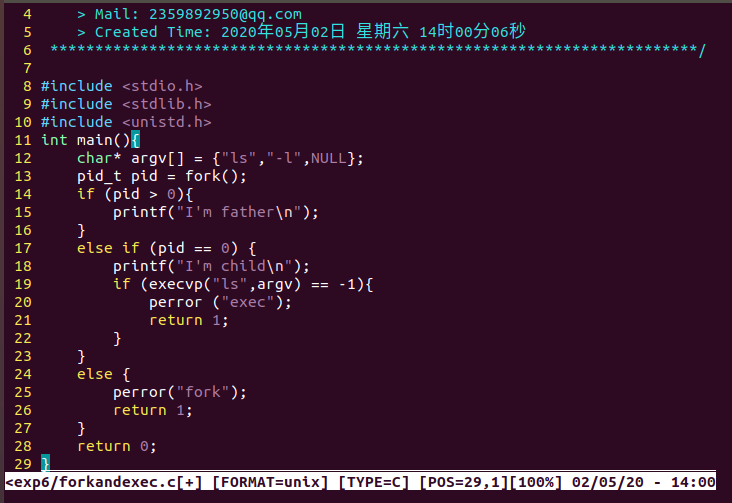
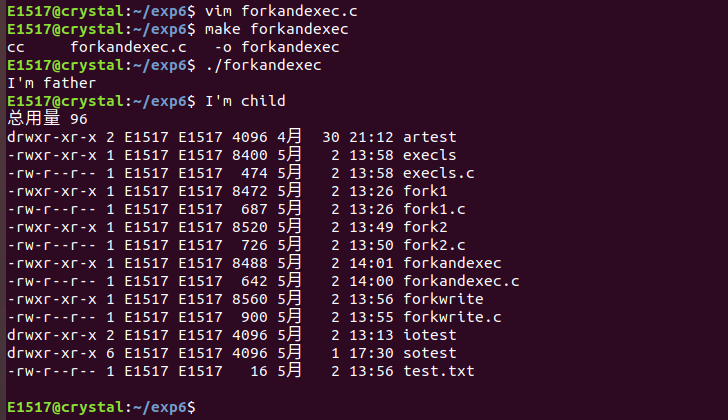
8、创建5个僵尸进程,并在终端通过 ps axf 命令查看僵尸进程信息。
#include <unistd.h>
#include <stdio.h>
#include <string.h>
int main() {
printf("before fork
");
pid_t pid, n = 5;
while(n--) {
pid = fork();
if (pid == 0)
break;
else if (pid < 0){
perror("fork");
return 1;
}
}
if (pid == 0) {
printf("hello, I'm child %d; my father is %d
", getpid(),getppid());
//getpid() 获取当前进程的pid
//getppid() 获取当前进程的父进程的pid
return 0;
}
while(1) {
sleep(3);
printf("hello, I'm father %d
", getpid());
}
return 0;
}
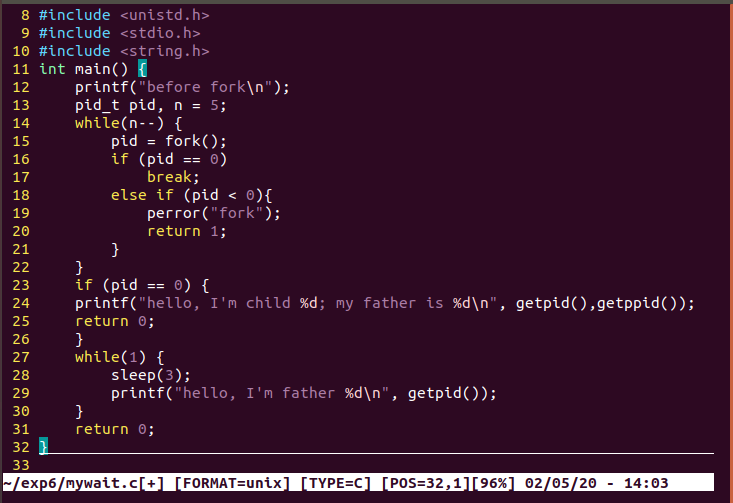

ps axf 显示进程见关联的树状结构图
另开一终端输入 ps axf 查看僵尸进程,显示如下:
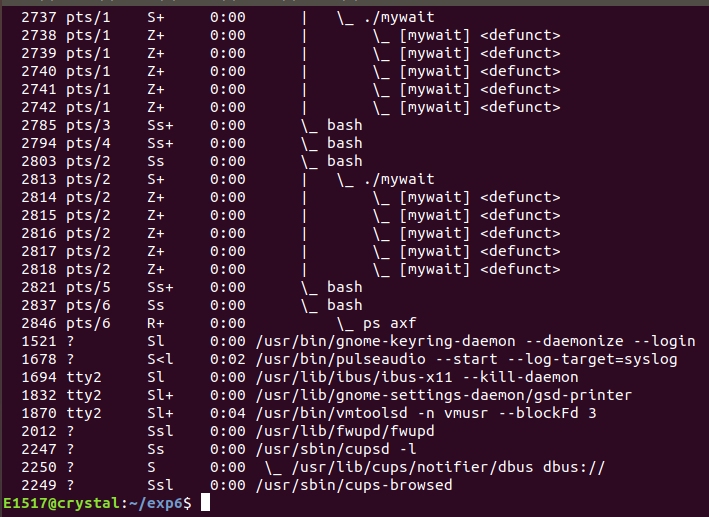
9、 通过 wait 来清理僵尸进程。
wait(等待子进程中断或结束)
(1)表头文件:
#include<sys/types.h>
#include<sys/wait.h>
(2)定义函数: pid_t wait (int * status);
(3)函数说明:
wait()会暂时停止目前进程的执行,直到有信号来到或子进程结束。如果在调用wait()时子进程已经结束,则wait()会立即返回子进程结束状态值。子进程的结束状态值会由参数status 返回,而子进程的进程识别码也会一快返回。如果不在意结束状态值,则参数status可以设成NULL。
(4)返回值:
如果执行成功则返回子进程识别码(PID),如果有错误发生则返回-1,失败原因存于errno 中。
#include <unistd.h>
#include <stdio.h>
#include <string.h>
#include <sys/wait.h>
#include <sys/types.h>
int main() {
printf("before fork
");
pid_t pid, n = 5;
while(n--) {
pid = fork();
if (pid == 0)
break;
else if (pid < 0) {
perror("fork");
return 1;
}
}
if (pid == 0) {
printf("hello, I'm child %d;my father is %d
",getpid(),getppid());
return 0;
}
while(1) {
sleep(3);
pid = wait(NULL);
if (pid == -1) {
perror("wait");
sleep(10);
printf("I'm father %d;I have wiped out all zombies
",getpid());
return 1;
}
printf("Hello, I'm father %d; child %d exit
",getpid(),pid);
}
return 0;
}
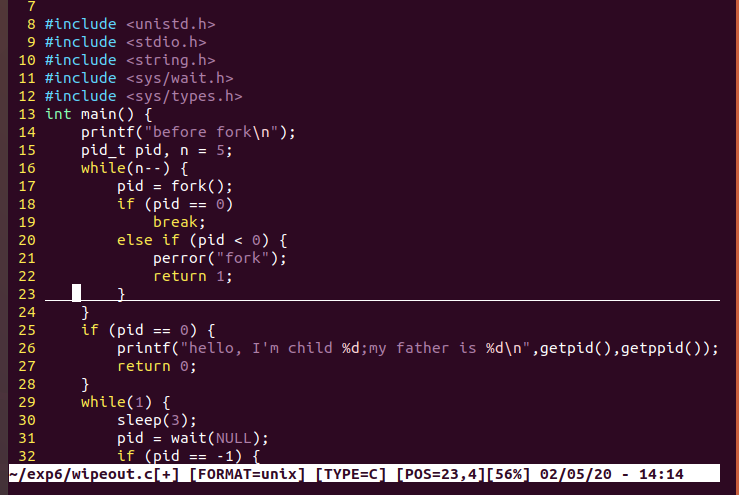

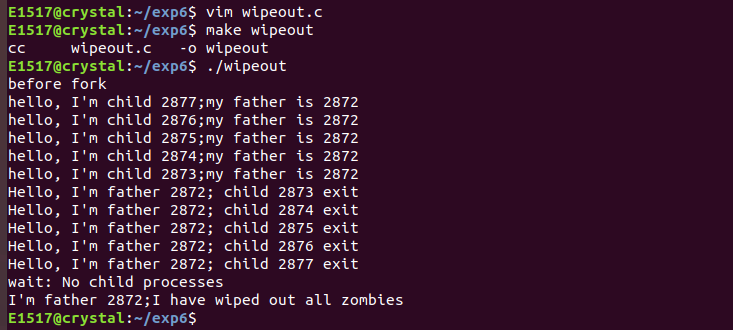
10、 父进程通过 waitpid 函数等待特定子进程结束,若该子进程不结束,父进程一直阻塞。
waitpid
(1)函数功能:用来等待某个特定进程的结束
(2)函数原型:
pid_t waitpid(pid_t pid, int *status, int options);
(3)参数:
status如果不为空,会把状态信息写到它指向的位置
options允许改变waitpid的行为,最有用的一个选项是WNOHANG,它的作用是防止waitpid把调用者的执行挂起.
(4)返回值:成功返回等待子进程的pid,失败返回-1
#include <stdio.h>
#include <signal.h>
#include <unistd.h>
#include <errno.h>
#include <sys/types.h>
#include <sys/wait.h>
#include <stdlib.h>
void handler(int sig)
{
pid_t pid;
while ((pid = waitpid(-1,NULL,WNOHANG)) > 0)
{
printf("wait child sucess : %d
",pid);
}
}
int main()
{
signal(SIGCHLD,handler);
pid_t pid = fork();
if (pid == 0)
{
printf("child1 pid : %d
",getpid());
sleep(3);
exit(1);
}
pid_t pid2 = fork();
if (pid2 == 0)
{
printf("child2 pid2 : %d
",getpid());
sleep(5);
exit(2);
}
pid_t pid3 = fork();
if (pid3 == 0)
{
printf("child3 pid3 : %d
",getpid());
sleep(7);
exit(3);
}
printf("father pid : %d
",getpid());
while (1)
{
printf("father do self
");
sleep(1);
}
return 0;
}
